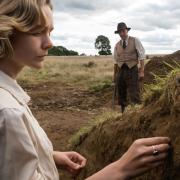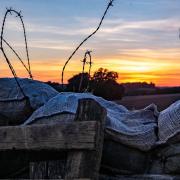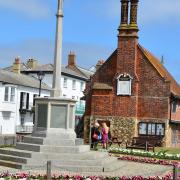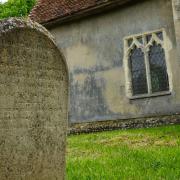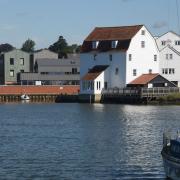Suffolk-born writer and sailor Paul Botterill voyages to Orfordness to pay tribute to the lighthouse that has guided seafarers for more than two centuries

A small white speck gleams in the sun, a bright contrast in the graphite line of land dividing sea from sky. It is the top of the Orford light. . . but not for much longer. It’s being dismantled to save it from the ever-encroaching sea.
I want one last look before it goes and am sailing to bid adieu. A gentle southeasterly breeze and ebbing tide make the voyage easy, I will cover the 15 miles from Shotley in two to three hours.
Looking at the land from seaward is different, like peeking through the window of a familiar house. “That which you knew so well is quite transformed” as poet and yachtsman Hilaire Belloc wrote. For landsmen, the sea is usually journey’s end but for the sailor it’s the opposite. A landfall signals arrival. Lights have guided seafarers since ancient times. The sea is horizontal and featureless so the higher the better. The first recorded navigation light was in Piraeus in the fifth century BC, two centuries before the great ‘pharos’ of Alexandria.
Orfordness lighthouse is modern by comparison, built in 1793 for Lord Braybrook under a grant from the burgesses of Aldeburgh. At 30 metres high it is visible from 13 miles away. The rotating lens which shone a single beam once every five seconds was fitted in 1880 and used until 2013 when it was extinguished, services no longer required, made obsolete by radar and satellites.

It was a reassuring beacon approaching this precarious coast at night. Navigators will no longer experience the satisfaction, and often relief, on siting that reassuring loom sweep across the night sky and counting “one elephant, two elephant, three elephant, four elephant, five elephant” before the next sweep, and thinking, “That’s Orford, I know where I am.” How ironic that the radar that hastened its demise was first tested in the secret laboratories of this isolated place.
The light has gone and soon the red and white striped tower will follow, the only vertical colour in this flat, taupe landscape. After 200 years of service it will soon join previous structures that stood sentinel over what Belloc called The Cape of Storms.
This distinctive tower has saved many lives. On a late January afternoon in 1940, a lone Spitfire from Manston, Kent patrolling over a convoy chased an approaching bomber back across the North Sea. With his radio out of action and heavy cloud down to 400 feet, 19-year-old pilot Geoff Wellum was lost.
Dropping below the clouds he flew west above the waves until he saw a line of surf and the candy striped lighthouse. “I know,” he said, “Orfordness.” He got home safely – just.
Three miles west stands the keep of Orford Castle, built in 1165 on the orders of Henry II. It cost him a fortune, one tenth of his revenues. It is another useful landmark although in the late 18th century the Marquis of Hertford, owner of the castle, wanted to demolish it for the building materials. Only the intervention of Trinity House saved it.
Hard building stone has always been scarce on this sedimentary coast. Stone to build the castle was imported from Normandy and a special channel was dug from the river towards the town to unload the heavy cargo. The depressed land alongside Quay Street marks its course.
Orford was important even before the conquest. The Danes sacked it before moving inland and murdering Saint Edmund at Bury in 870AD. Later, Orford man Henry de Glanville stopped on his way to the second crusade to lead the siege of Lisbon in 1147. The pillage was considerable and his son, Hervey, build nearby Butley Abbey with some of the proceeds. Again the stone came from Normandy.
Find out more about Suffolk’s coastal history
Although important, Orford was overshadowed by Southwold and Dunwich further north along the coast where a large haven was sheltered by a long shingle spit. Between them they sent 80 ships to help transport Henry III’s army invade France in 1224 but 60 years later a great storm swept away the protective spit.
The haven was gone and most of the spoil washed south onto the coralline crag ridge that is the bedrock of Orfordness. As the Ness grew so did Orford’s trade and in 1381 a beacon was erected on the new promontory to mark the entrance to the harbour. It was the year of Watt Tyler’s revolt, just a few years after the Black Death had swept the land.
The fortunes of this coast have waxed and waned as the sea has given and taken away over many generations. Subconscious memories know that only the elements, the forces of nature, are eternal. Just how ancient was revealed in September 1931 when Ted Lockwood, the 31-year-old skipper of the Lowestoft trawler Colinda hauled up a lump of solidified peat in his nets.
The slab was too big to lift and throw overboard so he broke it with a shovel. To his surprise, a sharpened bone fell out which was later identified it as a red deer antler shaped into a barbed harpoon. When it was eventually carbon dated in 1988 it proved to be from the late Paleolithic era about 12,000BC, a time when the landmass between Britain and continental Europe was inhabited by tribes of hunter-gatherers.
How so called Doggerland came to an end remains a mystery. Perhaps a gradual rise in sea levels as the ice age receded followed by the cataclysmic Storegga event, when land the size of Scotland fell from the Norwegian coast into the sea sending out enormous waves that would have covered that land.
Were there any survivors? Did some of them head west to our eastern shores? Does some latent memory still lurk deep in the psyche of their descendants? Is that the source of the dogged tenacity of people who have survived on this fragile frontier twixt land and sea ever since?
When Britain became an island the coast was several miles east of the present littoral, and history records ”in the ninth century the shore was not a flat shingle beach but exceedingly steep and rocky”. The 30 metre underwater cliff on the eastern side of the Shipwash bank, five miles offshore, supports that statement and makes me wonder what I am sailing over. Are there the ossified remains of oak, lime and elm trees or the sedimentary crag once thought to be fossilised dinosaur droppings?
Ships for the journey
Passing the red and white Woodbridge Haven buoy and looking back, the container cranes silhouetted above the Felixstowe rooftops look like a row of grazing prehistoric reptiles.
We don’t know exactly when or how our forebears took to the sea but bronze made locally about 4,000 years ago required tin and copper and the nearest source of tin was Cornwall. In the fifth century BC settlers from Europe crossed the North Sea bringing the alchemy of iron smelting with them. They also knew how to build the ships for such a journey and could navigate the myriad hidden sandbanks on the way.
At that time Orfordness was probably an offshore island or even a sandbank. The river Alde emptied into the sea at Slaughden where archeological finds suggest a port of some importance. On the same latitude across the North Sea, the bathing resort of Domberg was a major port. An exceptional low tide in 1647 uncovered two roman temples with votive offerings for cargoes of wine and olive oil destined for Britannia. The limestone blocks were quarried in northern France and weighed more than two tons.
After the Romans abandoned Britain an estimated 100,000 migrants crossed the North Sea – Jutes, Angles and Saxons. Why they came remains a mystery. Was it rising sea levels, marauding neighbours or perhaps some mysterious attraction to find forgotten Doggerland kinsmen? We underestimate the distances people and goods travelled in those misnamed ‘dark ages’. Among the treasures at Sutton Hoo was lapis lazuli from Afghanistan.
By the time the Normans arrived, Norfolk and Suffolk were the most densely populated places in Britain with flourishing fishing and wool trade. The Doomsday Book recorded that half the peasantry in these two counties were freemen compared to only 14 percent nationally. Is this what makes them so independent minded, what one time vicar of Aldeburgh George Crabbe described as “wild, artful, surly and savage”?
Red bands in sight
I pass the Orford Haven buoy into Hollesley Bay. I can see the two red bands on the lighthouse while to port the conspicuous towers of Orford castle and St Bartholomew’s church stand above the town. In the bay a single boat is lifting pots and out to sea a giant container ship outbound from Felixstowe looks like a tower block adrift in mid-ocean. No wonder the sea is empty – these behemoths can carry a quarter of a million tons with a crew of perhaps 20 people. How different from the 400 vessels Geoffrey Arnott reported anchored here in Story of a Suffolk River.
Trinity House took control of the Orford light in 1836 paying Lord Braybrook and the Crown £145,000 in compensation, equivalent to £20 million in today’s money. Lighthouses were profitable business. Light dues were levied on passing vessels and the profit for the final five years of Braybrook’s enterprise averaged £13,500. At a penny per ton and 240 pence to the pound and allowing for some operating and maintenance costs, there must have been close to 5 million tons of shipping going past each year, requiring about 10,000 ships.
Servicing their needs provided a living for many small boats working out of Orford and the Aldeburgh beach. Most were honest but inevitably there were some rogues and rascals. Ships attract pirates like scavenging seagulls.
The chronicles of Edward II refer to the appointment of a commission in 1322 to judge Thomas de Aldeburgh accused of filibustering the La Welyfare de Hamburgh. Sadly nothing is known about Thomas but he was certainly not the last of the local pirates. Almost 300 years later, Martin Frobisher, celebrated explorer of the Northwest Passage, was imprisoned in the Moot Hall for piracy. Indignant, he petitioned Queen Elizabeth who instructed his release. She had of course invested in his ventures and no doubt enjoyed the substantial profits they made. The line between piracy and war was flexible and thin.
As the Ness grew ever southward, the port of Orford declined and Aldeburgh grew, reaching its zenith in Elizabethan times and rich enough to attract the attention of ‘Dunkirkers’, piratic raiders from only 12 sailing hours away in France. A petition to Queen Elizabeth for the defence of the town claimed 1,300 men were engaged in fishing for herring, sprats and cod travelling as far as ‘Yselande’, landing 100,000 herring, 30,000 sprats and 4,000 cod in a single year.
Drake’s ship Pelican, later renamed the Golden Hind, was built on the Hundred River at nearby Thorpe. The Burgesses of Aldeburgh sent five ships to confront the Spanish Armada and one, the Marygold, captained by Francis Johnson, became the seal of the borough.
Lifesavers
I am approaching the lighthouse close to shore. The wet stones below the tideline glisten in the sun like amber and the only sound the gentle hiss of waves on shingle. It is easy to forget how hazardous seafaring used to be and I recall Arnott’s thought, “How many Aldeburgh and Orford men have been dashed to pieces on those treacherous stones or under the onslaught of the snarling waves?”
The scale of carnage is hard to imagine. Thirty-two ships and over 1,000 men were wrecked on Orfordness in a single night in 1627. In November 1711 Captain Norcliff wrote to Daniel Defoe in the midst of a violent storm describing the destruction of eight ships. Defoe was so horrified that he undertook further investigation and estimated the loss of life that night exceeded 8,000 souls.
The scale of losses provoked demand for a rescue service and the need for unsinkable lifeboats. The first in Suffolk was at Bawdsey in 1800 which was moved to Aldeburgh in 1824 where there has been one ever since, crewed by successive generations of the same families like the Cables.
Lifeboatman Thomas Cable drowned during a rescue operation off Sizewell in 1855 and his grandson James became the celebrated coxswain 33 years later. The tradition continued. In February 1954 the lifeboat was called to assist the Kentbrook aground three miles south of the town. Aboard was 15-year-old Patrick Cable, James’ great grandson but under the official age to embark. When challenged, his mother replied: “They’ll never keep a Cable out of the lifeboat.”
Old Fitz and the sea
As I arrive in front of the lighthouse I have a little time before the tide will turn to carry me back. The beach is steep enough to put my bow ashore and place an anchor but it could easily drag through shingle so I move offshore and heave to, make things shipshape and wonder what those men who risked their lives going to sea out of necessity would think about those of us who do it for enjoyment?
One of the earliest yachtsman was the eccentric genius Edward Fitzgerald. He called his 40-ft ketch Scandal because he said, “nothing travels faster”. He recalled seeing the white sails of ships above the trees from his nursery at Bredfield and dreaming of liberation. Angry at the changes to the countryside, he took to the water because “it is where no friends are buried or paths stopped up”.
One day when walking along the Aldeburgh sea front wearing his habitual large cloak, boa scarf and slouch hat tied with a handkerchief, a visitor asked a local fisherman who it was. “Why that’s Old Fitz,” he replied, tapping the side of his forehead and adding, “everyone knows him, and there’s many as call him dotty.”
Old Fitz promoted Aldeburgh’s virtues to his friends and colleagues, seeding the local creative community that has thrived ever since.
The rhythm of the waves has changed, quickening as the new flood tide pushes against the wind. It’s time to go. The tide will carry me back to Shingle Street and over the bar into the river, home from the ‘boundless deep’, to quote Tennyson, home to the river Alde, my maritime alma mata, where I first learned to sail before going to sea myself.
I raise my arm in salute at the abandoned light on the deserted shore and all those who sailed these waters before.
About Paul Botterill
Suffolk born, Paul Botterill has been sailing on the East Coast for more than 60 years. After service in the Royal Navy he spent 40 years in the world of container shipping. He still enjoys exploring the creeks and swatchways of our local rivers and estuaries looking for places most sailors rarely go.





